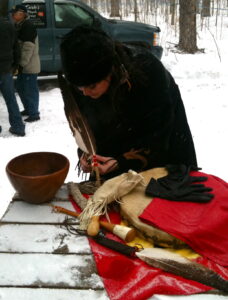I had the honour this week to perform the first “ceremonial” tapping to mark the launch of the maple syrup season in the province. Members of the Ontario Maple Syrup Produers, media and guests gathered at Terry & Vickie Gervais’s farm, Trillium Ridge Sugarworks ( Mah- Kwan Kadeek), located in Tyendinaga Township, just outside of Belleville. We gathered around an campfire in their woods and opened the event with a traditional Onkwehonwe blessing from Kim Maracle. It was a smudging ceremony used by all First Nations people. She gave a few words of thanks in Kanienkehake (Mohawk language) to the Creator and to the animals, trees and the wahta (sweetwater). Her ceremonial props included eagle feathers, sage, sweetgrass, cedar and ceremonial tobacco. We also got to participate and had an opportunity to throw some tobacco on the fire. Following the ceremony and remarks by MC Ron Hubbs (Hubbs Sugarbush and Sweetwater Cabin in Prince Edward County) & other guests, the tapping event came next.
With a power drill in hand, I had the priviledge of drilling the first hole and hammering a tap into the tree (no thumbs lost).We were then treated to some local sausages, homemade maple baked beans, pancakes and of course, maple syrup. There was a real sense of community throughout the morning, with the shared appreciation and acknowledgment that our first crop of the season had a long and special Canadian heritage.
Terry & Vickie also named their farm, “Mah-Kwan Kadeck” from the language of the Maliseet Indians of New Brunswick. It translates to the place where maple sugar is made. Most Indians living near the inland waterway of the Great Lakes and the St. Lawrence Valley produced maple sugar as their basic source of sweetener many years before the Europeans arrived. An Indian male was usually in charge of boiling sap while his wife and children assisted by gathering wood. Sap was placed into hollowed basswood logs. Hot stones were then placed into this sap, causing it to evaporate until only maple sugar crystals remained. Forty drops of sap make one drop of maple syrup. In the beginning it was birch bark containers and log troughs. It then moved to wooden buckets and iron kettles. Today, maple syrup producers use plastic pipelines and modern evaporators.
No matter the method, I’m thankful for this sweet crop and look forward to cooking many dishes with Canada’s first natural taste of Spring. (more photos on Facebook – From the Farm Cooking School)
[fusion_builder_container hundred_percent=”yes” overflow=”visible”][fusion_builder_row][fusion_builder_column type=”1_1″ background_position=”left top” background_color=”” border_size=”” border_color=”” border_style=”solid” spacing=”yes” background_image=”” background_repeat=”no-repeat” padding=”” margin_top=”0px” margin_bottom=”0px” class=”” id=”” animation_type=”” animation_speed=”0.3″ animation_direction=”left” hide_on_mobile=”no” center_content=”no” min_height=”none”]
[/fusion_builder_column][/fusion_builder_row][/fusion_builder_container]